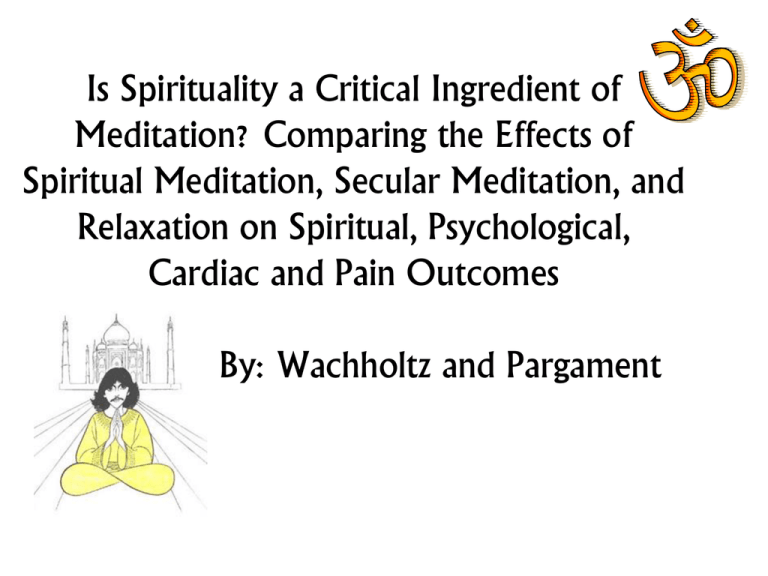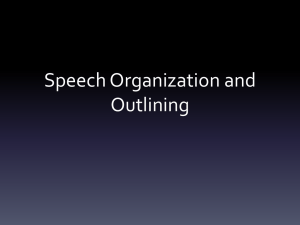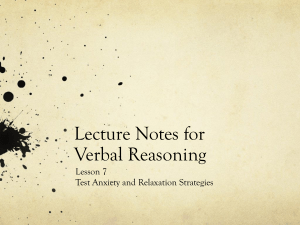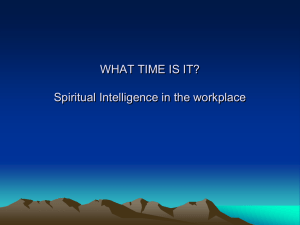Is Spirituality a Critical Ingredient of Meditation? Comparing the
advertisement

Is Spirituality a Critical Ingredient of Meditation? Comparing the Effects of Spiritual Meditation, Secular Meditation, and Relaxation on Spiritual, Psychological, Cardiac and Pain Outcomes By: Wachholtz and Pargament • Stress causes a variety of physiological changes in the body, including increased cortisol levels, anaerobic cellular activity, heart rate, and blood pressure- over time this can lead to permanent negative consequences on health • Research indicates that meditation can suppress these stress reactions and even reverse some of the negative consequences caused by prolonged exposure such as chronic pain • While a number of studies have shown positive correlations between religion and health, mental stability, and longevity, few studies have used a treatmentoutcome design to compare religious or spiritual interventions with their secular counterparts • Thus a major question involving meditation is whether spiritual meditation has advantages over secular meditation Religious Meditation and Health • Many cultures around the world integrate meditative practices into their religious and spiritual disciplines • Many of these forms use meditative phrases to focus the mind on spiritual concepts • Used to lower heart rate, blood pressure, metabolism, galvanic skin response, respiration rate etc. In addition participants report improved health and greater relaxation after meditation • It has been suggested that spirituality can also affect pain tolerance. For example, among advanced oncology patients, religious beliefs correlate with happiness, life satisfaction, decreased reports of pain and less perceived pain Meditation Intervention Studies • Transcendental Meditation (TM) remains one of the few well studied forms of spiritual meditation • TM consistently yields more positive effects than secular relaxation techniques- compared to secular practitioners, TM practitioners show significantly more improvements on measures of trait anxiety, drug use/abuse, self actualization, and health factors • In a study comparing a Christian devotional meditation (DM) to progressive muscle relaxation (PMR)- participants who practiced DM 20 mins a day for two weeks reported less anxiety and anger and had less muscle tension than those who practiced PMR; indicating quiet religious reflection was associated with better results than PMR Current Study • Purpose: To examine whether spiritual meditation is associated with more beneficial outcomes than other forms of meditation and relaxation • Hypothesized that individuals in the spiritual meditation group will have more pain endurance, reduced anxiety, improved mood, and report more feelings of spiritual well-being than the other two groups Session 1: • Participants filled out session 1 packet which included demographics, daily spiritual experiences questionnaire (DSE), state-trait anxiety inventory (STAI) and Fetzer spirituality measure • Randomly assigned to one of three groups: • Relaxation--not given instructions on how to mentally occupy themselves but told not to sleep or think stressful thoughts) • Secular meditation--offered choice of 4 meditative phrases to focus attention on while meditating- “I am content”, “I am joyful”, “I am good”, “I am happy” • Spiritual meditation—offered choice of phrase that best fit them spiritually- “God is peace”, “God is joy”, “God is good”, “God is love” (could change if God didn’t fit their spirituality • Asked to practice technique 20 mins a day for two weeks Session 2 • Came back two weeks later for individual appointments • Heart Rate was taken, practiced technique for 20 mins while HR was taken at 10 min intervals, then began cold pressure(CP) task while continuing meditation or relaxation technique. • Length of time hand remained in water was recorded and HR was taken at two min intervals until it got back to pre-CP HR • Filled out session 2 questionnaire packet which included Positive and Negative Affect Scale (PANAS), State-Trait Anxiety Inventory (State and Trait), Spiritual Well-being scale (SWB), Daily spiritual experiences questionnaire (DSE), Mysticism scale and a manipulation check regarding experiences with assigned technique Results: • Participants heart rate was significantly lower after practicing their assigned technique for 20 minutes compared to baseline, suggesting the techniques created significant cardiovascular relaxation Anxiety (as measured by STAI-T & STAI-S) • The spiritual meditation group reported significantly less trait anxiety and endorsed significantly fewer state anxiety statements than the other two groups Mood (as measured by PANAS) • No significant differences for negative emotions but the spiritual meditation group reported significantly more positive mood than secular and relaxation Spiritual Health (as measured by SWB) • Participants in spiritual meditation reported significantly greater existential well being (spiritual interactions between self and others), also reported that they felt significantly closer to God at post –test. No differences pre-test Spiritual Experiences (as measured by DSE and the mysticism scale) • Spiritual meditation group reported significantly more daily experiences of a spiritual nature • Also endorsed significantly more mystical experiences statements Cold Pressure Task • Significant differences in the mean duration the participant’s hand was in the water- Individuals in spiritual meditation group’s hands remained in water on average for over a minute and a half, whereas secular remained 46 seconds and relaxation 49 seconds. • Spiritual well-being correlated with better psychological health • There was an inverse correlation between positive mood and trait anxiety and both were related to pain tolerance, suggesting a connection between psychological factors and ability to tolerate pain • Participants in the spiritual group who displayed greater pain tolerance also reported richer spiritual lives Study Conclusions • In general, the spiritual meditation group reported lower anxiety, more positive mood and greater spirituality. They also displayed an ability to withstand pain for longer periods of time than the other groups • The addition of the spiritual focus to a meditative task resulted in better mental health and was more beneficial than secular meditation and relaxation • Interestingly, pain perception didn't appear to be altered by the use of spiritual meditation- all three groups reported that they experienced the same subjective level of pain even though results showed that pain tolerance was indeed affected • It is suggested that an improvement in mood affects pain tolerance- anxiety often reduces the ability to cope effectively with pain and thus positive mood and lower anxiety would result in a higher pain tolerance Is Spirituality a critical ingredient of meditation? • The current study suggests that secular meditation tasks represent lessspiritually oriented rather than non-spiritually oriented meditation tasks • Because secular meditation rose out of spiritual traditions, at least some effects of secular meditation may still be rooted in spirituality • Even though members of the secular meditation group meditated on secular phrases (“I am good, I am happy etc.), they still reported increases in the number of daily spiritual experiences- this number should not have been affected if it was truly devoid of spirituality • This suggests that some processes such as meditation likely have an inherent spirituality that can arise even within secular contexts Andes survivors: • The nightly praying of the rosary and conversations with God, particularly Canessa’s while on the rescue trek can be likened to a kind of spiritual meditation • Likely that this resulted in increased positive mood and lower anxiety under their circumstances • May have aided in their ability to endure the freezing temperatures • Also could have helped them better tolerate the pain from the injuries sustained in the crash • Parrado and Canessa’s ability to scale a 15,000 foot mountain and continue on to find help despite the pain and fatigue they felt







